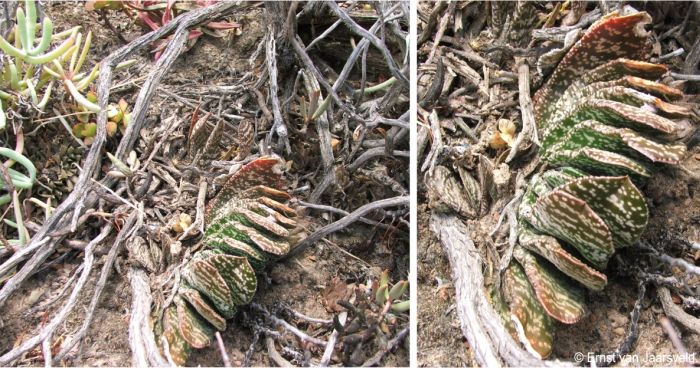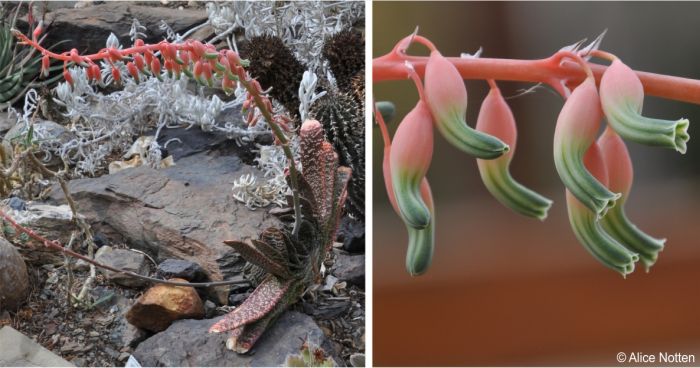Gasteria retusa
Gasteria retusa (Van Jaarsv.) Van Jaarsv.
Family: Asphodelaceae
Common names: Hex River ox-tongue (Eng.), Heksrivier beestong (Afr.)
Introduction
Gasteria retusa is a cluster-forming leaf succulent of about 240 mm in diameter. The leaves are beautifully ornamented, wrinkled, with transverse bands and leathery tubercles and a notched end. The inflorescence is a raceme of orange-pink flowers in late winter. It grows in dry Succulent Karoo vegetation near Worcester on the Hex River Mountains and eastern extreme of the Langeberg and adjacent territory. Best for containers.

Fig. 1. Gasteria retusa growing on the farm Orange Grove, near Worcester, Hex River Mountains.
Description
Description
The plants grow in stemless (acaulescent) clusters to 150 mm tall and to 240 mm in diameter. Plants are initially solitary, with ascending growth, proliferating from the base to form small, dense groups. The leaves are in an opposite row (distichous), tongue-shaped (lorate), 30–150 mm long and 10–35 mm broad at the base, the inner erect, lower leaves becoming spreading. The upper surface is plane or slightly convex and the lower surface rounded. Both surfaces dark green, tuberculate, spotted, with raised or immersed, white-domed tubercles in obscure transverse bands. The leaf margin is rough and the teeth white, tuberculate, leathery. The leaf tip is truncate or notched (retuse), rarely blunt (obtuse), and with a small hard point (mucronate). The juvenile leaves in an opposite row (distichous), erectly spreading, tuberculate, tongue shaped (lorate), the tips blunt and also ending with a small hard point (mucronate). The inflorescence consists of a simple raceme 150–450 mm tall, spreading and slightly curved. The stalk of the inflorescence is 5 mm thick at the base, the pedicels 8–9 mm long. The flowers (perianth) are about 22 mm long, stipitate for 1–2 mm. The swollen flower base (gasteriform portion) up to 8 mm diam., pink; thence constricted to a tube of 4 mm diam., white with centric green stripe. The ovary 6.5 mm long; 2 mm broad; style 9 mm long extending to 11 mm at end of the flowering period. The stamens about 19 mm long, the anthers oblong, 2 mm long, included within the flower. The capsule 19–23 mm long, oblong, 7 mm broad. Seeds 3–4 mm long, 2 mm wide. Flowering time is in winter and spring (July–September, Southern Hemisphere).

Fig. 2. Illustration of Gasteria retusa by the botanical artist Rita Weber.
Conservation Status
Status
Gasteria retusa is a rare species and although the plants are confined to a few sites, and some (5%) of its habitat has been lost to vineyards, most of the population occurs on steep, unploughable slopes and is thus not, at present, threatened, according to the Red List of South African plants.

Fig. 3. The habitat of Gasteria retusa at the farm Orange Grove, near Worcester, Hex River Mountains, Western Cape.
Distribution and habitat
Distribution description
Gasteria retusa grows on the lower south-facing slopes of the western end of the Langeberg between Worcester and Nuy and the adjacent Hex River Mountains. The substrate consists of shale soils, mainly derived from Malmesbury Group (Noree Formation).
Gasteria. retusa grows in succulent-rich Robertson Karoo vegetation, which is part of the Rainshadow Valley Karoo of the greater Succulent Karoo Biome (Mucina & Rutherford, 2006). It is found on steep slopes in a rocky terrain with scattered shrubs, such as Carissa haematocarpa, Euclea undulata and Searsia undulata, and small trees such as Olea europaea subsp. africana and associated succulents including Haworthia reticulata, Aloe microstigma, Adromischus maculatus and A. filicaulis subsp. marlothii, Antimima sp., Curio radicans, Lampranthus haworthii, Cynanchum viminale, Cotyledon orbiculata var. orbiculata, Crassula atropurpurea, C. perforata and C. rupestris, Euphorbia burmannii and Pelargonium alternans.
The climate of the Robertson Karoo is one of hot, dry summers with maximum temperatures above 30°C and short, moist, cool winters. If frost occurs, it is very light. Rainfall is mainly in winter but some rain can also occur in spring or autumn, associated with thunder showers. The rainfall is between 200 and 300 mm per annum (May to September). The advantage of rainfall during the winter is that moisture persists for much longer. Gasteria retusa grows in localized populations at an altitude of about 300-400 m.

Fig. 4. Gasteria retusa growing in its habitat at Orange Grove Farm near Worcester.
Derivation of name and historical aspects
History
The name Gasteria is derived from the Greek gaster, meaning ‘belly’, referring to the stomach-shaped flowers. The species name retusa describes the shape of the leaf, rounded with a slight notch at the tip.
Gasteria retusa was first collected by Mr. Hugo Naude in August 1924, at Keerom Buttress, north-east of Worcester. It was first formally described as Gasteria carinata var. retusa by Ernst van Jaarsveld in 1992 and in 2007 its status was raised to species level (Van Jaarsveld 1992, 2007). It can be confused with both Gasteria disticha and G. langebergensis. The undulating and distinctly tuberculate leaves of which the leaf tips are often notched (retuse) is diagnostic, separating it from Gasteria disticha of which the leaves are not tuberculate and with a matt surface. G. langebergensis is somewhat similar to but also has a matt leaf surface.

Fig. 5. Gasteria retusa in flower in the Stone Plant House, Kirstenbosch NBG, and a close-up of the gasteriform or ‘belly-shaped’ flowers characteristic of the genus.
Ecology
Ecology
Gasteria retusa, like most other species of Gasteria, grows in dappled shade of small shrubs in its Karoo habitat. The plants benefit from the protective cover of thorny ‘nurse’ shrubs such as Carissa haematocarpa. The mottled leaves of Gasteria retusa allow it to blend in with its environment making it inconspicuous and difficult to detect. Also, the leaves of the plant are brittle and the leaf sap also not bitter. The natural enemies are herbivores such as rock rabbits (Procavia capensis) and porcupines (Hystrix africaeaustralis). When plants are grazed, any broken or damaged leaves in the leaf litter will callus and spontaneously root, soon forming plantlets. The plant thus uses the disturbance and damage as a means of vegetative regeneration. This is termed ‘passive resistance’. This vegetative reproduction method is also seen in many of the companion plants such as Adromischus, Crassula and others.
The succulent leaves of Gasteria retusa become turgid after rain in the winter months. This moisture-conserving strategy is essential for its survival during the long dry summer months. During periods of drought the leaves become reddish.
Growing below a nurse shrub such as Carissa haematocarpa also has its advantages. This nurse shrub not only provides shade during the long sunny days but the very thorny nature of the nurse shrub protects the succulent plants from grazers and trampling. Gasteria retusa has shallow roots and also benefits from the leaf litter layer.
The inflorescence appears in winter and the upper parts bearing the flowers are usually exposed above the canopy of the nurse shrub, thus clearly visible to, and pollinated by, local sunbirds. After successful pollination the capsule becomes erect and once ripe will open from the top, needing gusts of wind for effective dispersal of the seeds.

Fig. 6. A Southern Double-collared Sunbird (Cinnyris chalybeus) feeding on Gasteria retusa flowers in the Stone Plant House, Kirstenbosch NBG.
Uses
Use
Apart from its horticultural uses, the flowers of this species and other gasterias are edible and in some communities they are cooked in meat stew.

Fig. 7. Gasteria retusa in a container hand-made by the potter Ronnie van der Walt, at Babylonstoren Farm. Note the leaves becoming reddish.
Growing Gasteria retusa
Grow
Gasteria retusa is easily cultivated, either in containers or on rockeries. It makes a fine pot plant. To grow the plants out of doors, a Mediterranean-type climate is the best. Locally in South Africa, it can be grown in a succulent karoo garden (Van Jaarsveld 2010). Care should be taken that the soil is well-drained and the plants positioned with some protection against the sun. The plant prefers a shale-derived soil but sand, gravel and ample lime should be added. The plants will benefit from ample compost or an organic liquid fertiliser which can be applied one a year. Plants grow well in containers which can be placed on a shady windowsill or stoep (veranda). Water sparingly during winter and less so during summer.
Propagation is by division, leaf cuttings or seed. Sow seed in spring or summer in a well-drained sandy mixture. Cover the seed with a thin layer of sand. Protect from full sun and keep moist. Germination is within about 3 weeks. The young plants are slow-growing and can be planted in individual containers when big enough to handle. Divide plants when necessary. Leaf cuttings can be made at any time of the year. Preferably, remove a lower leaf by firmly holding the plant down with the one hand and remove the leaf with a twist from the other hand, or simply cut it near the base. Leave for about 3 weeks to allow the cutting to heal and plant, placing the leaf flat on the ground but with the lower portion partially covered in soil. Rooting is usually rapid when the leaf will become turgid. Young plants will proliferate from its base but leave until large enough to handle (after about 1 year).
References
- Keyser, N. 1997. Geological Map of the Republic of South Africa and the Kingdoms of Lesotho and Swaziland. Council for Geoscience, Pretoria.
- Mucina, L. & Rutherford, M.C. (eds) 2006. The vegetation of South Africa, Lesotho and Swaziland. Strelitzia 19. South African National Biodiversity Institute, Pretoria.
- Van Jaarsveld, E.J. & Raimondo, D. 2007. Gasteria retusa (Van Jaarsv.) Van Jaarsv. National Assessment: Red List of South African Plants version 2020.1. Accessed on 2023/11/14.
- Van Jaarsveld, E.J. 1992. The genus Gasteria, a synoptic review. Aloe 29(1):1-32.
- Van Jaarsveld, E.J. 1994. Gasterias of South Africa. A new revision of a major succulent group. Fernwood Press in association with the National Botanical Institute, Cape Town.
- Van Jaarsveld, E.J. 2007. The genus Gasteria, a synoptic review (new taxa and combinations). Aloe 44(4):84–103.
- Van Jaarsveld, E.J. 2010. Waterwise gardening in South Africa and Namibia. Struik, Cape Town.
- Van Jaarsveld, E.J. 2012. Gasteria disticha (L.) Haw. (Asphodelaceae). PlantZAfrica. Online. http://pza.sanbi.org/gasteria-disticha.
- Zonneveld, B.J.M. & Van Jaarsveld, E.J. 2005. Taxonomic implications of genome size for all species of the genus Gasteria Duval (Aloaceae). Plant Systematics and Evolution 251: 217–227.
Credits
Ernst van Jaarsveld
Kirstenbosch National Botanical Garden (Retired 2015)
Babylonstoren Farm
Extraordinary senior lecturer and researcher,
Department of Biodiversity and Conservation, University of the Western Cape
November 2023
Plant Attributes:
Plant Type: Succulent
SA Distribution: Western Cape
Soil type: Loam
Flowering season: Spring, Winter
PH: Acid, Alkaline, Neutral
Flower colour: Green, Pink, Orange
Aspect: Shade, Morning Sun (Semi Shade), Afternoon Sun (Semi Shade)
Gardening skill: Average
Special Features:
Horticultural zones







Rate this article
Article well written and informative
Rate this plant
Is this an interesting plant?
Login to add your Comment
Back to topNot registered yet? Click here to register.